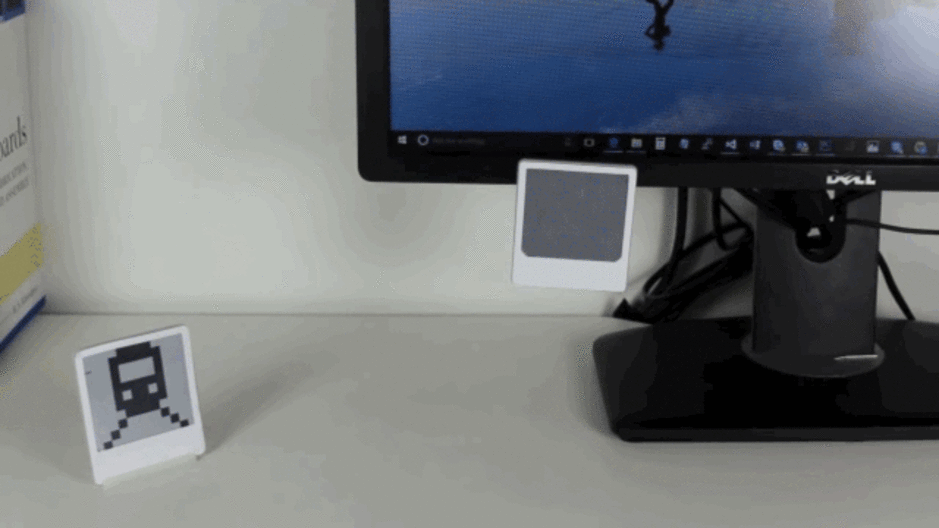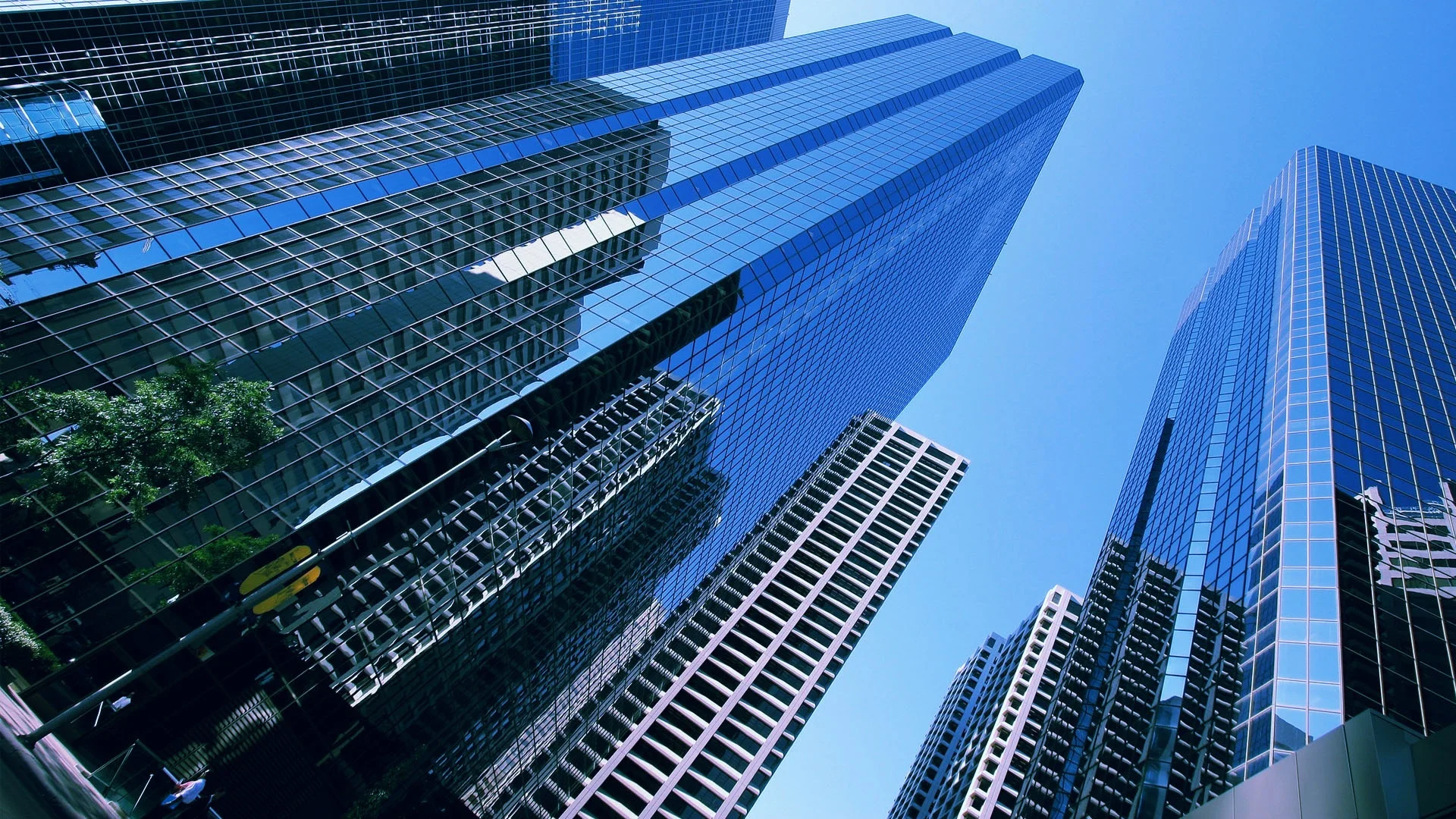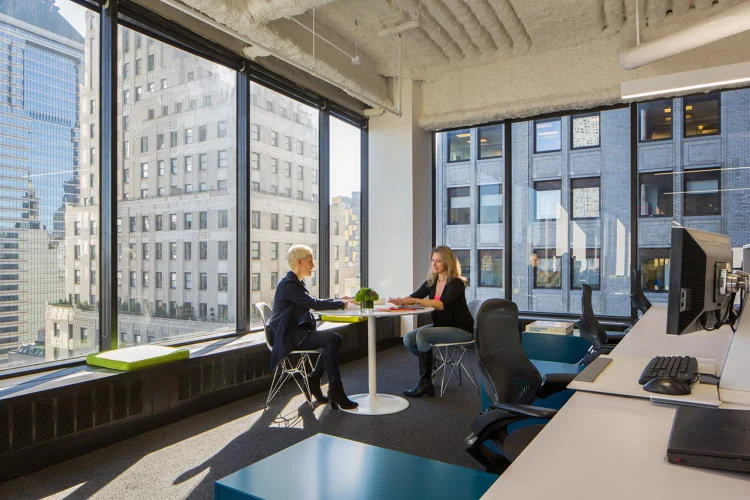Like most industries, healthcare is changing with new technology. In fact, healthcare may even be evolving at a more rapid pace than other industries because of the impact new technology can have on almost every aspect of the system, from how doctors find results to how patients track their progress. What’s in store for the future of healthcare, and how does technology play a role? Jeroen Tas, CEO of Philips Informatics, gives his insights into a number of key areas.
Microsoft's Digital Post-It Is Powered By Your Office’s Horrible Lighting
Offices are littered with Post-it notes. Some argue for their greenness, others aren’t so convinced. But in any case, a tiny reusable display might make a better alternative in the long term—if only it didn’t require any extra power. And it so happens, scientists at Microsoft Research have developed just that.
Featured in New Scientist, and dubbed an "energy harvesting situational display," Microsoft's invention is a Post-it sized chunk of e-paper, the same stuff used in Amazon's Kindles. And simply through some solar panels placed on the display’s back, it can generate enough electricity to not only run continuously simply by sipping on the ambient light inside an office, but to actually update its display anywhere from two to sixty times per hour, depending on light levels.
Gartner report identifies the Top 10 strategic technology trends for 2017
A new report from tech analysts Gartner highlights the top technology trends the firm believes will be ‘strategic for most organizations in 2017’. Gartner defines a strategic technology trend as one with substantial disruptive potential that is just beginning to break out of an emerging state into broader impact and use or which are rapidly growing trends with a high degree of volatility reaching tipping points over the next five years. They include artificial intelligence, blockchain, intelligent devices, digital technology platforms and advanced machine learning.
Technology and Collaboration: A Vital Pair for the Future of Work
Between cloud services, video calling, internal social networks, and so much more, collaboration plays a huge role in modern workspaces. At the heart of collaboration is the technology that makes it possible. And for every type of collaboration software, there are multiple vendors and services offering various features and systems. Collaboration, while vital to the future of work, can also be overwhelming. But just as each organization has its own business plan and internal processes, so too does it need to have collaboration tools that meet its needs.
Tech Disruption’s Next Target: Office Buildings
Great technology in the workplace should have a positive impact on those running the building as well as employees in the tenant spaces, Comfy president Lindsay Baker tells GlobeSt.com. Baker, whose firm provides office technology geared toward keeping employees productive and comfortable, will be speaking during the session “Disruptive Technology” during NAIOP’s O.CON conference here in November. We spoke with her exclusively about the technologies shaping office product today and in the future, as well as how tech solutions are changing the way the office environment is managed and perceived by tenants.
Tech Trends of 2016: Campus Co-Working
Tech firms are playing a significant role in changing the way we work. Tech and start-up culture has long recognized the benefits of co-working spaces and their relationship to fostering innovation. Now, more traditional industries, including media, healthcare and finance, are recognizing this modern work style’s appeal: serendipitous encounters, community, the free exchange of advice/ideas and shared purpose.
The need to attract young talent, along with lack of affordable real estate and the desire to do meaningful work, have contributed to co-working’s increasing popularity. Whether it’s a large corporation installing teams in external co-working spaces or finding like-minded companies to co-locate on their campuses, the goal is the same: to come together to help fuel new ideas, improve products and push the world forward.
VR May Be A Legitimate Design Tool Sooner Than You Think
Tiltbrush is the ultimate sketching app. You can decorate a snowman, wireframe a tiny house, or draw jaw-dropping landscapes, filled with dragons made of flame paint that stretch the length of your living room. But there’s a catch: while you can technically export the images to 3D software to play with further, there’s no seamless, Adobe-style workflow for VR content. And so no one seriously designs in VR.
Productive mobility is poised to give business a virtual boost
Throughout history, new technologies have constantly changed the way we’ve worked. They’ve been responsible for full-scale revolutions. And continued investments have come as corporate demand for worker productivity drives tech spending.
We should expect augmented reality (AR) and virtual reality (VR) to eventually attract increased spending in the enterprise as they combine with new mobile network advancements to make an emerging trend called “productive mobility” a reality.
Productive mobility is about being as productive out of the office as inside, and as productive in a virtual instance as a physical one.
Tech Trends of 2016: Lifestyle as Currency
Tech companies see the workplace as a physical experience that serves as an extension of brand and culture. A company dictates the brand, but the individuals dictate the culture, and when the two merge, it creates a style that is authentically them. By moving towards designed spaces that are much more purposeful and memorable, tech companies are placing focus on the high caliber of their work and their employees.
CoreNet report sets out how technology will reshape corporate real estate
The speed of today’s technological advances is dramatically reshaping the way that corporations manage and use their real estate. It’s a dynamic that has significant consequences for the workplace, urban development and the overall lifestyle of the average worker. Those are the unsurprising conclusions of a new report from trade association CoreNet Global, which was discussed this week at the organisation’s 2016 Summit – EMEA, held in Amsterdam. As ever, the devil is in the detail so the report is worth exploring to get a sense of just how imminent many of the changes will be, especially because they will converge to create a perfect storm of change for the workplace. This marks the new era out from the past when technology developed in more predictable ways. Several CoreNet Global Gold Strategic Partners contributed to the report including CBRE, Deloitte, ISS, JLL, Newmark Grubb Knight Frank, Sodexo and Steelcase.
Could Sensor Networks Be The Secret To Less Hellish Offices?
Open offices aren't going anywhere soon. But an experimental sensor network and app from NBBJ might make them more tolerable.
The offenses of open offices are numerous and well-documented: noise, frigid air (and its cousin, blazing heat), and productivity- and creativity-killing distractions, to name a few. The reality of rising rents and limited space means that open-plan workspaces won't go away completely. But the architecture firm NBBJ has a solution to make them more tolerable: an experimental sensor network and smartphone app named Goldilocks that lets workers find space in their office that's not too hot, not too loud, and otherwise just right.
Here's how design and tech are making shared workspaces more productive
It can be a lonely road for the freelance worker. Lots of work is solitary by nature, but for freelancers who typically work from home or the local cafe, the isolation and lack of collegial interaction can be, well, unproductive.
"When you are your own boss ... you are responsible for everything that you do," Leo Newball, a freelance web developer, said in a phone interview. "I need a space where I can detach from waking up and just working in my bedroom. That wasn't working at all for me."
How to choose and deploy interactive technology in the workplace
We worked with Applied Global Technologies (AGT) to come up with 7 Tips for Deploying New Interactive Technologies in the Workplace. Here are some of our top tips for choosing the interactive solution that's right for you and your organization:
There's no such thing as flexible
Technology was meant to herald a new way of working anytime, anywhere – but that’s not the case, writes Georgina Kenyon.
We didn’t get the flying cars or the self-lacing shoes. But we did get the work world of the future – you know, the one where the internet allows us to work anytime, anywhere, resulting in the death of the 9-to-5 life.
The Art of Rendering: How Technology Will Revolutionize Architectural Representations
Ahead of the upcoming d2 Conferences taking place in Vienna this August, we caught up with Jeff Mottle — visualization evangelist and founder of CGarchitect — to get his take on the state of the industry and exciting new developments transforming the field of architectural representation. Mottle’s unique background, encompassing architectural design, visualization and business development, makes him a leading authority on all things ArchViz.
CGarchitect went live 15 years ago and has since evolved into a go-to source of information on architectural visualization and a community platform with over 80,000 forum members and 1.3 million unique visitors per year. It is hard to imagine anyone whose work relates to architectural representation not having posted a comment on the forum, read a tutorial, gotten inspired by the huge gallery of images or looked for a gig in CGarchitect’s jobs section. In addition to running the website, Mottle speaks at events around the globe.
The Smartphone Revolution: What it Means for CRE Brokers
As it currently stands, commercial real estate is a mobile industry without mobile tools. Brokers spend an average of 50% of their time away from their desk and in the field. This contradiction yields one of the biggest sources of frustration for today’s commercial broker.
Augmented Reality Could Speed Up Construction Projects
Employees at Gilbane Building Company, a commercial construction firm based in Rhode Island, usually work off paper blueprints or with digital models that they view on computers or iPads. But Gilbane senior manager John Myers now gets a closer look by putting Microsoft’s augmented-reality computer, HoloLens, on his head.
When Myers recently put on HoloLens to look at a mockup of a project, he could see that steel frames the company planned to order to support the building’s walls were too long to fit the design. Having spotted the issue ahead of time, the company can now ask the supplier to cut the frames shorter in his shop rather than make workers adjust dozens of tracks that would hold the frames in place. Myers estimates that the move will save Gilbane about $5,000 in labor costs.
The office is not dead – but it must be reimagined
We live in a time of great upheaval. Whether it is advances in healthcare, transportation or technology, our day-to-day lives are close to unrecognisable from 30 years ago.
The one uniting factor of our era is that nothing can be taken for granted – society is in a state of constant flux, adapting to new challenges, thoughts and ideas.
WELCOME TO AIRSPACE How Silicon Valley helps spread the same sterile aesthetic across the world
It’s easy to see how social media shapes our interactions on the internet, through web browsers, feeds, and apps. Yet technology is also shaping the physical world, influencing the places we go and how we behave in areas of our lives that didn’t heretofore seem so digital. Think of the traffic app Waze rerouting cars in Los Angeles and disrupting otherwise quiet neighborhoods; Airbnb parachuting groups of international tourists into residential communities; Instagram spreading IRL lifestyle memes; or Foursquare sending traveling businessmen to the same cafe over and over again.
We could call this strange geography created by technology "AirSpace." It’s the realm of coffee shops, bars, startup offices, and co-live / work spaces that share the same hallmarks everywhere you go: a profusion of symbols of comfort and quality, at least to a certain connoisseurial mindset. Minimalist furniture.
Why Minecraft predicts the future of collaborative work
Minecraft is like an immersive digital Lego set. It lets you build whole worlds out of a few simple categories of digital bricks. Then you can invite your friends or anybody with a Minecraft account to enter those worlds and interact with them, change them or create parallel worlds based on yours.
Once you learn the basics, the level of complexity you can build up to is virtually limitless. The style of play in Minecraft is also great training for the digital workplace: it’s collaborative, real time, iterative and largely open-ended.

























